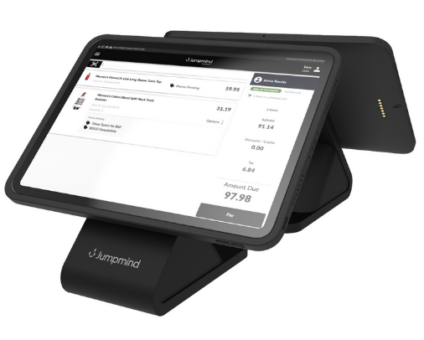Retailers are constantly looking for new ways to generate revenue and stay competitive. One strategy …
![]()
Cloud-native POS platform for seamless omnichannel customer experience.
![]()
A single hub for all promotions campaigns.
- Omnichannel ExperienceCreate seamless customer experiences
- Device IndependencePOS agnostic to form factor or operating system
- Self-CheckoutDo more with fewer associates
- Mobile StoreLeverage POS from anywhere
- POS on the GoEnable associates to sell outside of the store
- Unified PromotionsStreamline and simplify promotion workflows
- CX ConnectAllow customers to engage with POS during checkout
- Composable CommerceCreate the store experience you want
![]()
The most advanced synchronization solution for databases and file systems.
![]()
Data configuration and batch automation across different disparate systems and vendors.
-
Data Replication
- Multi-tier DistributionReplicate thousands of remote locations
- Cloud Database ReplicationCapture live changes from on-premise to the cloud
- High Availability and Load BalancingEnsure 24/7 access to data and scale efficiently with demand
- Analytics and ReportingCapture the whole picture with real-time reporting
- Multi-masterMaintain consistency of data in a peer to peer setup
- Data WarehouseReplicate live and historical data to a warehouse
- MigrationsConduct live data migration with no downtime
-
-
Data Integration
- Master Data ManagementChanges propagate across the entire system, allowing you to maintain a centralized view of all parts of your core business entities.
- Application IntegrationReduce dependencies, complexity, and risk to build a high-performance, data-driven application.
- Web ServicesIntegrate multiple systems using web services or build a business application using a service-oriented architecture.
- Data WarehouseIntegrate disparate data from multiple systems so you can transform data for better business intelligence and reporting.
- Data MigrationConduct live data migration during critical server replacements, storage upgrades, and data center relocations—with no downtime.
- ImplementationIntegration consultants help design, develop, and deploy an implementation of our products.
- DevelopmentThe product developers can add features, enhance existing functionality or build support for new platforms.
- TrainingEngage our experienced training resources to gain in-house knowledge and expertise on Jumpmind products.
- SupportLeverage product engineers to resolve issues, fix defects and provide updates or patches.
- Proof of ConceptDetermine the feasibility of implementing our products and get answers to your questions quickly.
Clienteling isn’t a new theory. It can be traced back hundreds of years when shopkeepers …
BOPIS, BORIS, and Curbside Pickup offer consumers and retailers the best of both worlds. …
View all Blog Posts
The SymmetricDS product can synchronize data between over forty different database platforms with out of …
Compare and Repair for SymmetricDS Pro can compare two databases, report on the differences, and …
Mobile replication with Android edge devices in near real time to an on-premise or cloud …
View all Blog Posts
Jumpmind President and CEO Joe Corbin to Lead Panel on Agility at Scale and Digitalizing …
Retail Technology Leader Jumpmind Brings Newfound Interactive and Personalized Digital Engagement to Inspire Shoppers at …
Retail Technology Leader Jumpmind Provides Enhanced Experiential Point of Sale and In-Store Engagement for Build-A-Bear Workshop …
View all Blog Posts
![]()
Cloud-native POS platform for seamless omnichannel customer experience.
![]()
A single hub for all promotions campaigns.
![]()
The most advanced synchronization solution for databases and file systems.
![]()
Data configuration and batch automation across different disparate systems and vendors.
-
Data Replication
-
-
Data Integration
-
Retail Retail trends, technology, and enhancing the customer experience
-
Data Thoughts on data matters, dialects, performance, and security
-
Case Studies How Jumpmind impacts the businesses of our clients
-
Videos & Webinars Watch on demand demos, reviews, and tours of our products
-
Company News Get the scoop on Jumpmind's growth and impact
View all Blog Posts
Urban Outfitters Open Source Refresh

A retailer chooses SymmetricDS to synchronize Oracle POS MySQL store database with central office DB2 database.
The Organization

Headquarters
Philadelphia, PA
Industry
Retail
Number of Nodes
300+
Urban Outfitters chose to refresh their Oracle POS (ORPOS) based store infrastructure, moving from a mostly IBM based store stack to an open source based store stack. SymmetricDS was chosen to replace an MQ Series solution as the data delivery mechanism to anchor the new store infrastructure.
The Challenge
The challenge was to deliver to the retailer a proven data movement solution that could deliver the massive number of master item and pricing data to multiple brands in a timely manner, and also trickle sales back to the central office throughout the day. The solution also needed to decrypt and re-encrypt sensitive data as it hit the safe harbor of the central office as well as map several simple data elements to new values for back-end systems.
Another requirement also existed to deliver a subset of the central office sale and item data to another centralized MySQL database which was a data source for a custom web application used by the POS.
The Solution
Having implemented synchronization for ORPOS in the past, JumpMind quickly setup a standard synchronization profile between the MySQL store server and the DB2 central office database. SymmetricDS was used to capture and trickle back sales and electronic journal data. It was also used to move item, price, tax and hierarchy data to the store database. The master item table was routed using the lookup table routing feature of SymmetricDS. The routing leveraged a table that mapped store to brand. Re-encryption of sensitive data was accomplished using a bean shell script column data filter at the central office SymmetricDS instance. Simple data mappings were also accomplished using the same mechanism.
Not only was SymmetricDS used move data between the store and the central office, but it was also used to move data to the second centralized datasource. In order to do this, a third node group was created. As data trickled into the central office, the required data for the secondary data source was captured and routed to the additional node group.
The Results
SymmetricDS allowed the retailer to have a resilient and consistent mechanism for moving business critical data both to and from their stores. SymmetricDS provided an affordable alternative to better known, but more expensive messaging alternatives which required more software to execute at the store itself.













